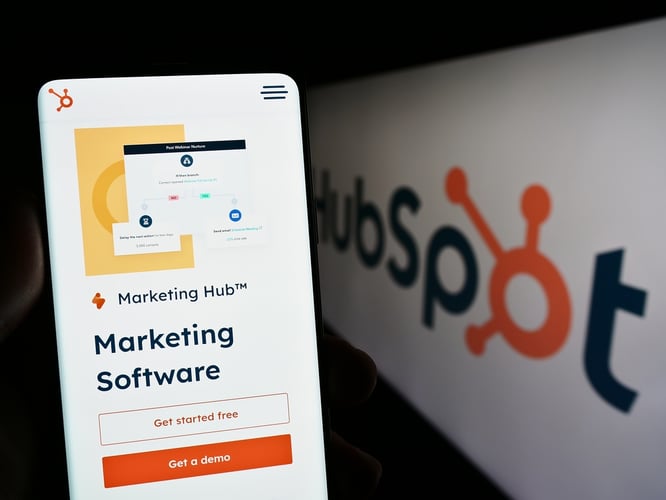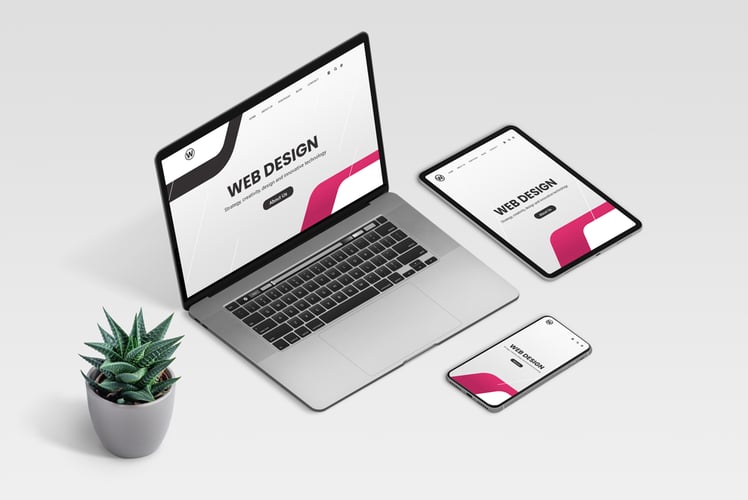Achieving a strong and effective online presence is very important, and this is not only achieved through creativity but above all through functionality. In this sense, it's essential to know which parts of a website play a fundamental role.
Think about it... when you enter a website and can't find what you're looking for almost immediately, what do you do? You leave! A poorly structured or organized website leads to missed opportunities, as it's the first impression of a company.
Therefore, it's crucial to have a well-structured and designed website that is not only attractive but also built to enhance your brand's visibility. So, take note of the 10 essential parts of a website that cannot be missing for you to create or redesign it successfully.
Why Have a Website?
Having a website is incredibly important nowadays. They say that if you're not on the web, you don't exist, and there are many reasons to say and support this. Let's look at some of the main benefits that having a website provides for businesses.
1. Visibility
When people are looking for products, services, or information, their first instinct is to search online, right? Because practically anything can be found there, and almost instantly.
For starters, it's crucial because you can use SEO techniques to capture a greater amount of traffic, according to your strategy and target audience.
Here, two things need to be considered: first, visibility, which allows your target audience to find you online, know you exist, and discover what you offer, allowing them to choose you later.
Secondly, online presence, which is the mere fact of being on the internet, whether through a website, social media account, etc. Here, it doesn't matter whether the site is targeted to our audience or not.
Additionally, remember that a website allows you to be visible to potential customers 24 hours a day, 7 days a week, and on a global scale.
2. Credibility and Professionalism
A well-designed and maintained website can help improve your business's perception, as it gives the impression that you take your work seriously and reinforces your brand.
Several factors come into play here, for example: the design, as it needs to be appealing to keep users engaged; the architecture, as information should be easy to find to create a good experience; the usefulness of information, etc.
Visitors, consciously or subconsciously, associate the quality of your website with that of your products or services. Therefore, if a potential customer searches for your business online and doesn't find a well-designed and easy-to-navigate website, they may question your company's legitimacy.
3. Information and Customer Service
A website can act as an information hub for your customers, providing details about your products or services, answering frequently asked questions, and offering ways to get in touch.
For this purpose, it's very important to know exactly where to place these elements on your website, making them easy to find so visitors can contact you whenever they want without too much trouble.
Try to keep your forms short and concise, as if they are too extensive, users might lose interest due to the tedious process. No one wants to waste time on that, right? Quick contact is the way to go these days.
Furthermore, features like live chat, inquiry forms, and blogs can enhance the customer service experience.
4. Sales and Marketing
A website plays a key role in the business strategy. In terms of informative websites, it needs to be able to attract the right people and convince them that your product or service is the best through your value proposition.
If it's meant to capture leads, it needs to invite visitors to leave their details in a form to be contacted by a salesperson. In the case of an e-commerce site, it needs to guide the customer through the entire sales process.
Does your website fulfill this? If not, you should reconsider whether it's really working or if you need to redesign it.
For this purpose, you should analyze your company's situation, set your objectives, and identify how important your website is in achieving them.
In terms of marketing, a website enables companies to implement search engine optimization (SEO) strategies. By appearing in relevant search results, you can attract more visitors and increase the visibility of your brand.
5. Competitiveness
In many sectors, if you don't have a website, you're falling behind. Your competitors are probably already online, attracting your target audience, and maybe even converting them into customers.
Having a website allows you to compete on equal footing and even surpass your competitors with better web design, superior user experience, and effective digital marketing strategies.
Stay ahead by analyzing your competition and figuring out how you can create a much better designed and optimized website. Don't take it as something to copy but as something to draw inspiration from and improve upon.
Essential Parts of a Website
Now, let's get to the important part: the elements that must not be missing on your website if you really want it to work.
1. Header
The website header is like a book cover; it needs to capture attention and give a clear idea of what's inside.
It usually includes your company's name and logo, as well as a navigation menu that guides visitors to different parts of the website.
It might also contain additional elements such as contact information, social media links, and a search bar.
Remember, the header is one of the first things a visitor will see, so it should be visually appealing, clear, and functional.
The goal is for visitors to immediately identify who you are and what you do. For instance, Coca-Cola's website has a clear and effective header that highlights its logo and provides useful links.
It can also be useful to include a call to action (CTA) in the header, like a "Buy Now" or "Contact Us" button, to guide people toward a specific action you'd like them to take.
2. Navigation Menu
The navigation menu is like the map of your website. It allows people to explore different sections of your site easily and quickly. The key here is simplicity: it has to be intuitive, well-organized, and contain links to the most important parts of your website.
Furthermore, it needs to be placed prominently, preferably in the header, so users can find it easily. For example, Apple's navigation menu is simple, clear, and user-friendly, with links to its main products and services.
When designing the navigation menu, it's essential to consider the mobile experience, as more and more people access the web via mobile devices. Ensure that it's easy to use on screens of different sizes.
3. Main Content
The main content of your website is where the "meat" is. This includes everything from detailed descriptions of your products or services to informative blog posts or image galleries.
This is the section that your visitors have come to see, so it should be relevant, useful, and engaging.
Quality main content can help improve your website's credibility, provide value to people, and increase your visibility in search engines.
For instance, Tesla's website has detailed product pages for each car model, containing information about features, technical specifications, images, and videos.
Remember, high-quality content is essential for SEO. Therefore, make sure it's well-written, relevant to your target audience, and strategically includes keywords.
4. About Page
The "About" page is your opportunity to tell your story and showcase your brand's personality. It can include details about your company's history, mission, values, and the team behind your business.
This part of a website is particularly important for building trust and credibility. Visitors want to know who you are and what you care about.
For instance, Starbucks' "About Us" page talks about their commitment to quality coffee, community, and staff.
Additionally, including images or videos on your "About" page can help make your business feel more real and personal to people.
5. Blog
A blog is a platform where you can regularly share relevant and valuable content. This can include everything from industry news and useful tips to case studies and guest posts.
This part of a website is crucial because it can establish your company as a leader in your industry, attract more traffic, and improve your search engine ranking.
Furthermore, it allows you to build a relationship with your customers by providing them with value on a regular basis.
To maximize the impact of your blog, it's important to publish regularly, optimize your posts for SEO, and promote them through your marketing channels.
6. Call to Action (CTA)
A CTA is an invitation for visitors to take a specific action. It can be as simple as "Buy Now," "Subscribe to Our Newsletter," or "Contact Us." Each page of your website should have a clear goal, and the CTA should guide people toward that goal.
A good CTA is clear, prominent, and persuasive. It should stand out visually and use language that motivates people to take action.
Additionally, CTAs can be a powerful tool for lead generation and converting visitors into customers. By guiding them through the purchase or subscription process, you can increase your chances of making a sale or gaining a new follower.
7. Contact Form
Provide an easy way for visitors to send you a message, request a quote, or ask for more information. It's an essential tool for generating leads and improving customer service.
Furthermore, placing a contact form can increase people's trust in your business. It shows that you're available and willing to help.
When designing your contact form, remember to keep it simple. Only ask for the information you really need and make sure it's easy to find and use.
8. Testimonials
Testimonials are comments or reviews from satisfied customers. They can be a powerful tool for building trust and persuading visitors to become customers. After all, people tend to trust other customers more than they trust companies themselves.
Including testimonials on your website can help showcase the quality of your products or services and demonstrate that you can deliver on your promises.
Make sure to get permission before publishing testimonials and consider including a photo of the customer and their full name to increase authenticity.
9. FAQ Page
The Frequently Asked Questions (FAQ) page is where you can answer the most common questions visitors have. This saves time for your customers and your customer service team.
A good FAQ page not only provides answers to common questions but is also easy to navigate and search.
Keep your FAQ page up to date. As your business grows and changes, so will your customers' questions.
10. Footer
The footer should not be left out when considering the parts of a website, as it's like the end of a book. It provides additional information and often includes links to sections like privacy policy, terms and conditions, contact information, and sometimes a secondary navigation menu.
Although it might be easy to overlook, it's an important element in website design. It can help visitors find relevant information, improve the user experience, and enhance your site's credibility.
For example, Google's website footer includes links to important information such as privacy settings and terms of service.
Additionally, this section can be a great place to add additional elements like links to social media, copyright information, and a "Back to Top" link to improve navigability.
Your Website with Ocean Pro
Having a website is very important, and now that you know the 10 parts that cannot be missing on your page, let me tell you that it's not so complicated to achieve.
There are multiple options, and at Media Source, we offer an effective one: Ocean Pro, a professional theme that provides these and more modules and sections for you to build a functional and appealing website.
Best of all, you DON'T need to know about coding or anything technical. You can set it up 100% through the HubSpot CMS builder.
Ocean Pro is 100% customizable and designed to allow any business to enhance its online presence.
Are you ready to build or improve your online presence? Contact us! We can help you create your website or redesign it to make it work and reach your buyer personas, converting them into more sales.

.png?width=319&height=267&name=gtmetrix_2023%20(1).png)




